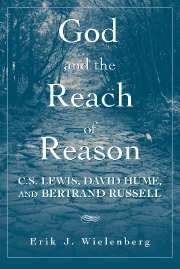4 - Faith, Design, and True Religion
Published online by Cambridge University Press: 05 June 2012
Summary
INTRODUCTION
The discussion to this point has focused primarily on areas of disagreement among Lewis, Hume, and Russell. The present chapter is devoted to an examination of some areas of agreement among the three thinkers. In particular, we will focus on the nature of faith, the status of arguments from design, and the nature of true religion. We will see that the things about which the three agree are fundamental and sometimes surprising.
FAITH
Lewis and Russell on faith
Faith is often contrasted with reason. The popular expression “taking a leap of faith” expresses this idea; the leap alluded to is a leap beyond what can be established by reason and evidence. The contemporary humanist and Russell scholar A. C. Grayling succinctly summarizes this popular view:
Faith is a negation of reason. Reason is the faculty of proportioning judgment to evidence, after first weighing the evidence. Faith is belief even in the face of contrary evidence. Soren Kierkegaard defined faith as the leap taken despite everything, despite the very absurdity of what one is asked to believe.
A famous remark by Tertullian, an early Christian thinker, illustrates this conception of faith in action: “The Son of God died; it must needs be believed because it is absurd. He was buried and rose again; it is certain because it is impossible.” On this view, believing something “on faith” is an irrational activity.
- Type
- Chapter
- Information
- God and the Reach of ReasonC. S. Lewis, David Hume, and Bertrand Russell, pp. 153 - 202Publisher: Cambridge University PressPrint publication year: 2007



